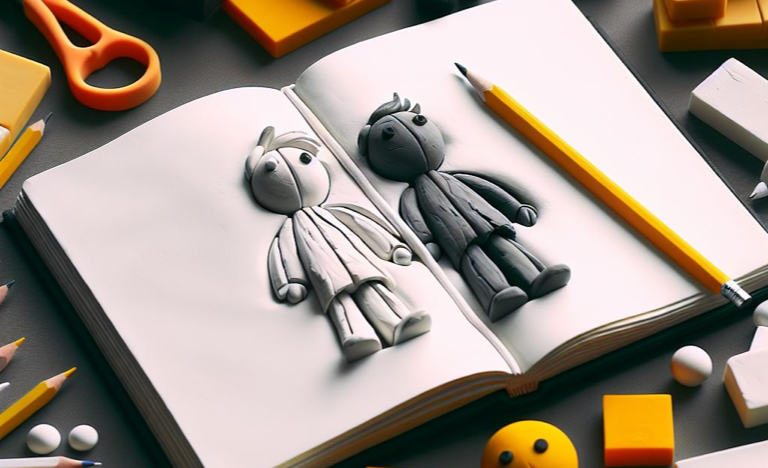Flat characters are characters that lack the depth and complexity of round characters. They serve the story, they are static, they do not evolve, and they have no edges, complex motivations, or internal dilemmas. They are often archetypes whose purpose is to advance the plot or function as a foil for other characters.
Although flat characters are talked about as something negative, literature is full of examples of flat characters that work, and we even like them as readers. And we do not only find them in novels! Classic sitcoms are a genre that usually uses flat characters because they focus on anecdotes and jokes and seek a feeling of familiarity—without complications, resorting to common patterns that the viewer recognizes at the moment.
How to Identify Flat Characters?
When writers begin to shape their first works, they often encounter criticism or fear that their characters are too flat. Fortunately, it is not hard to avoid this mistake and identify a flat character, since they have distinct traits that set them apart:
1. They Are Less Complex
Flat characters do not have internal conflicts or dilemmas. While the round characters try to represent an actual person with all their edges, the flat character is a mere sketch. Their features are simple, and their reactions are predictable. They aren’t ambiguous, nor do they move through gray areas. What you see is what you get.
2. They Are Easy to Summarize
Flat characters could be considered wildcard characters, effortlessly summarized in a few words. They are easy to classify, and they will never deviate from their role. For example, in a high school teen novel we can create a bully or a cheerleader. They are flat archetypes that we easily identify.
We could give them some complexities, of course: A bully who actually dreams of being a tap dancer, a cheerleader who works at night in a secret laboratory… But this would make them round characters and it could be counterproductive. Sometimes we just want those characters to work as a tool. Maybe we need the bully as an obstacle, like Crabbe and Goyle from the Harry Potter stories. Everyone knows what a bad bully is like and there is no need to tell much more about them.
3. They Do Not Evolve
Flat characters do not undergo a character arc, are not affected by plot events, and therefore do not change, internally or externally. But do not rely solely on the character arc to identify a flat character.
⚠️ Warning: Sometimes, we may confuse flat characters with static characters. Flat characters do not change during the story, but they are also two-dimensional. Static characters do not change during the story either, but they can have motivations, dilemmas, and complexities.
4. They Have a Predictable Nature
When we face a flat character, we instantly understand who they are and how they will react, often because they are based on well-known archetypes, sometimes even in stereotypes. The good thing about these types of characters is that they have always been with us. We have seen them a thousand times, and we know them well. We do not need to reflect on the behavior of a flat character. We already know how they will react without anyone explaining it to us.
🎓 Learn more: Archetypes Versus Stereotypes
Not all archetypes are flat characters. We can create well-rounded characters from archetypes. The distinction is that a flat character embodies all the characteristics we have just discussed. An archetypal round character evolves throughout the story and, while it may be easy to summarize initially, it becomes more complex as soon as you dig a little.


What Is the Purpose of Flat Characters?
A good story should never consist solely of flat characters. While you need to strike a balance or tend to round characters, you may still find it interesting to use a flat character in some circumstances:
1. To Simplify Plot-Driven Stories
In novels or scripts that focus on the plot, such as most short stories or Sherlock Holmes novels, overly complex characters can be problematic. When we need the audience to focus on what is happening rather than who it is happening to, flat characters become our allies.
2. To Serve as Foils to Main Characters
Flat characters may work as a contrast to highlight traits or evolutions of other characters in the story. We can use archetypal flat characters to represent the opposite that we seek to highlight in our protagonist. For example, Dr. Watson is a flat character that highlights Holmes’ intellectual prowess.
3. To Communicate a Moral
I personally believe that it is more effective to communicate a theme or a moral idea through a round character who faces an internal conflict. But sometimes the story may require something else or there may not be time for such a development. This is something that we find, above all, in the case of classical fables.
4. To Create Comedy
Flat characters are easily used in sketches, where the joke is above the character. They also work well in classic sitcoms, where the story is based on funny situations and easily recognizable characters. There is no complex plot to follow nor complex characters to analyze, but rather a simple story to relax and have fun with. But it is not just comedies that can benefit from a flat character: C3PO in Star Wars is a flat character who serves as the comic foil and tension reliever.
🎓 Learn more: How to Write Character Descriptions —Guide and Examples
How to Create Great Flat Characters?
Although it may seem contradictory, flat characters can be memorable. An example is Emperor Palpatine in the Star Wars saga. He may not be a beloved character, but he has become an icon. He lacks a backstory and does not undergo any character development. He is easily recognizable, summarizable, and works as a foil character. While Darth Vader has a backstory, internal conflicts, and ambiguities, Emperor Palpatine represents pure evil. Palpatine’s unadulterated wicked nature makes Darth Vader’s inner conflicts more significant.
So, as you have seen, flat characters can be impressive. But how do we do this? How do we create flat characters that our readers may enjoy and remember? There are a couple of specific tips that you can follow to create remarkable flat characters:
1. Using Flat Characters For Specific Functions
Don’t lose sight of the fact that flat characters are a tool, much more than well-rounded characters are. You should be very clear about their role in the story and ensure they do not stray from that role. Flat characters serve specific functions in the plot and must excel at what they do, and they stick to that play throughout the story.
2. Incorporating Subtle Complexities to Flat Characters
Yes, I know. This sounds like cheating. I have said many times in this post that flat characters don’t have complexities. But what if we incorporated a tiny trait that would make them unique?
I do not mean a very groundbreaking aspect, as this would be annoying for the readers, who have expectations already placed on our predictable character. But if, within their archetypal personality, we find a loophole to incorporate an insignificant quirk, an adorable gesture, or a weakness that makes them more charming, we would have an extra point so that our flat characters are not so easily forgotten.
Using C-3PO as an example from the Star Wars saga, he is an annoying, clumsy, and cowardly character. However, he brings humor to the story and possesses unique abilities, such as translating any known language in the galaxy. Additionally, he has a loyal friend, R2-D2, who takes care of him. If the endearing R2 feels empathy for C-3PO, we, as the audience, can also feel it through him.
Do Not Be Afraid of Flat Characters
I hope I have made it clear that flat characters do not have to be an element to avoid in our stories. Although we shouldn’t overuse them or include them without reason, flat characters also have their place in storytelling and contribute a lot to our works of fiction.
We have to learn to differentiate poor writing from well-used tools. If used wisely, flat characters can advance your plot without getting in your way or create an impact on the story without the reader losing focus on the main characters. Do not be afraid to include some flat characters, as long as you do it intentionally and consciously.
